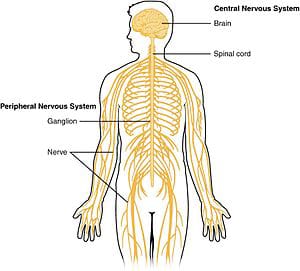MCQ ON CENTRAL NERVOUS SYSTEM class 11 for NEET | CENTRAL NERVOUS SYSTEM class 11| MCQ CENTRAL NERVOUS SYSTEM with Answer | Check the below NCERT MCQ question for class 11Biology based on the with Answers.
MCQ on CENTRAL NERVOUS SYSTEM class 11Biology with answers were prepared based on the latest pattern.We have provided class 11 Biology MCQs question with Answers to help students understand the concept very well.

MCQ ON CENTRAL NERVOUS SYSTEM class 11 for NEET
MCQ ON CENTRAL NERVOUS SYSTEM is useful for NEET / CSIR / UGC / CBSE / ICSE / AIIMS / EXAM / AFMC EXAM / STATE LEVEL MEDICAL EXAM/ KVS PGT BIOLOGY / NVS PGT BIOLOGY EXAM 2023-2024 ,2025
INTRODUCTION:-
CENTRAL NERVOUS SYSTEM:
THE BRAIN IS CENTRAL INFORMATION PROCESSING ORGAN OF OUR BODY and command and control system.
Controls the voluntary movement balance of the body, function of vital involuntary organs .It is the site of processing visions , hearing, speech , memory, intelligence, emotions and thoughts.
The human brain is well protected by skull. The brain is covered by cranial meanings. It consists of an outer layer called dura mater and very thin Middle layer called arachnoid and an inner layer called pia mater.
NEURONES ARE EXCITABLE cells because their membrane are in a polarised state.Different types of ion channels are present on the neural membrane.These ion channels are selectively permeable to different ions.
When a neuron is not conducting any impulse resting the axonal membrane is comparatively more permeable to potassium ions and nearly impermeable to sodium ions.
The human neural system is divided into two parts the central neural system and the periphere neural system.
The centre neuro system includes the brain and a spinal cord and he is the site of information processing and control.
Peripheral neural system comprises of all the nerve of the body associated with the central nervous system brain and spinal cord.
Peripheral neuro system of two types:-
Efferent fibers and afferent fibres.
The afferent nerve fibres transmit impulses from tissue organ to the central nervous system and the efferent fibres transmits regulatory impulses from the central neural system to the concerned peripheral tissues or organs.
The periphere neurosystem is divided into two divisions called somatic neural system and autonomic neural system.
The somatic neural system release in pulses from the central neural system to skeletal muscles while the autonomic noodle system transmits impulses from the central neural system to the involuntary organs and smooth muscles of the body.
Autonomic neural system is
further classified into sympathetic neural system and para sympathetic neural system.
A neuron is a microscopic structure composed of three major parts namely cell body, dendrites and axon.
The cell body contains cytoplasm with typical cell organelles and certain granular bodies called Nissl’s granules.
MCQ CENTRAL NERVOUS SYSTEM class 11 for NEET/KVS PGT BIOLOGY / NVS PGT BIOLOGY EXAM 2023-2024,2025
1. The human brain is well protected by
(a) skull
(b) arachnoid
(c) cell body and dendrites
(d) Schwann cells
Ans (a) skull
2. Inside is skull the brain is covered by
(a) potasium ions
(b) sodium ions
(c) magnesium ions
(d) cranial menings
Ans. (d) cranial menings
3. Inside the skull the brain is covered by cranial meanings consisting of an outer layer called
(a) arachnoid matter
(b) pia matter
(c) dura mater
(d) action potential
Ans. (a) dura mater
4. Cranial menings consists of very thin middle layers called
(a) synapses
(b) synaptic knob
(c) synaptic cleft
(d) arachnoid
Ans.(d) arachnoid
5. Cranial meanings contains an inner layer which is contact with the brain tissue called
(a) potasium ions
(b) pia mater.
(c) arachnoid mater
(d) dura mater
Ans.(b) pia mater.
6. The brain can be divided into major parts
(a) forebrain
(b) midbrain
(c) hindbrain
(d) all the above
Ans.(d) all the above
7. The forebrain consists of .
(a) cerebrum
(b) thalamus
(c) hypothalamus
(d) all the above
Ans.(d) all the above
8.The major part of the human brain is
(a) cerebrum
(b) cerebellum
(c) myelinated cells
(d) all the above
Ans.(a) cerebrum
9. A deep cleft divides the cerebrum longitudinally into two halves which are termed as the left and right
(a) action potential
(b) cerebral hemisphere
(c) Schwann cells
(d) cerebral cortex
Ans. (b) cerebral hemisphere
10. The hemisphere are connected by a tract of nerve fibres called
(a) hypothalamus
(b) Corpus callosum
(c) association areas
(d) Schwann cells
Ans. (b) Corpus callosum
11. The layer of cells which cover the cerebral hemisphere is called
(a) cerebral cortex
(b) dendrites
(c) synaptic cleft
(d) synapse
Ans.(a) cerebral cortex
12. The cerebral cortex contains
a) motor areas
b) sensory areas
c) association areas
(d) all the above
Ans . (d) all the above
13. A number of centres which control body temperature , urge for eating and drinking.
(a) hypothalamus
(b) cerebral cortex
(c) post synaptic membrane
(d) pre synaptic membrane
Ans.(a) hypothalamus
14. Dosal portion of mid brain consist mainly of four round swelling lobes called
(a) cerebral cortex
(b) excitatory
(c) corpora quadrigemina
(d) cerebral aqueduct
Ans. (c) corpora quadrigemina
15. The hind brain comprises
(a) pons
(b) cerebellum
(c) medulla
(d) all the above
Ans.(d) all the above
ALSO READ:-
● YOU CAN WATCH BIOLOGY SIR Youtube channel
16. The brain stem is consist of
(a) mid brain
(b) hand brain
(c) both a and b
(d) different types of ion channels are present on the neural membrane
Ans.(c) both a and b







Leave a Comment